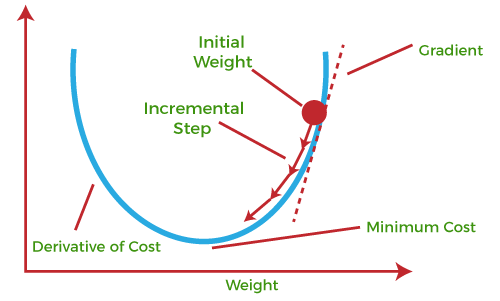Gradient Descent is defined as one of the most commonly used iterative optimization algorithms of machine learning to train the machine learning and deep learning models. It helps in finding the local minimum of a function.
The best way to define the local minimum or local maximum of a function using gradient descent is as follows:
If we move towards a negative gradient or away from the gradient of the function at the current point, it will give the local minimum of that function.
Whenever we move towards a positive gradient or towards the gradient of the function at the current point, we will get the local maximum of that function.
The main objective of using a gradient descent algorithm is to minimize the cost function using iteration. To achieve this goal, it performs two steps iteratively:
Calculates the first-order derivative of the function to compute the gradient or slope of that function.
Move away from the direction of the gradient, which means slope increased from the current point by alpha times, where Alpha is defined as Learning Rate. It is a tuning parameter in the optimization process which helps to decide the length of the steps.
What is Cost-function?
The cost function is defined as the measurement of difference or error between actual values and expected values at the current position and present in the form of a single real number.
Types of gradient Descent:
Batch Gradient Descent: This is a type of gradient descent which processes all the training examples for each iteration of gradient descent. But if the number of training examples is large, then batch gradient descent is computationally very expensive. Hence if the number of training examples is large, then batch gradient descent is not preferred. Instead, we prefer to use stochastic gradient descent or mini-batch gradient descent.
Stochastic Gradient Descent: This is a type of gradient descent which processes 1 training example per iteration. Hence, the parameters are being updated even after one iteration in which only a single example has been processed. Hence this is quite faster than batch gradient descent. But again, when the number of training examples is large, even then it processes only one example which can be additional overhead for the system as the number of iterations will be quite large.
Mini Batch gradient descent: This is a type of gradient descent which works faster than both batch gradient descent and stochastic gradient descent. Here b examples where b<m are processed per iteration. So even if the number of training examples is large, it is processed in batches of b training examples in one go. Thus, it works for larger training examples and that too with lesser number of iterations.

